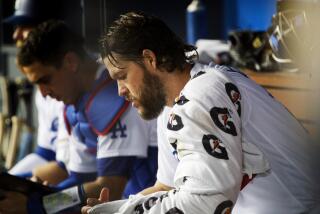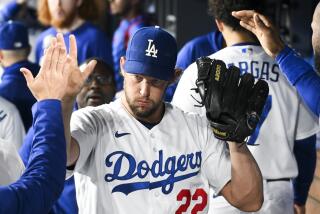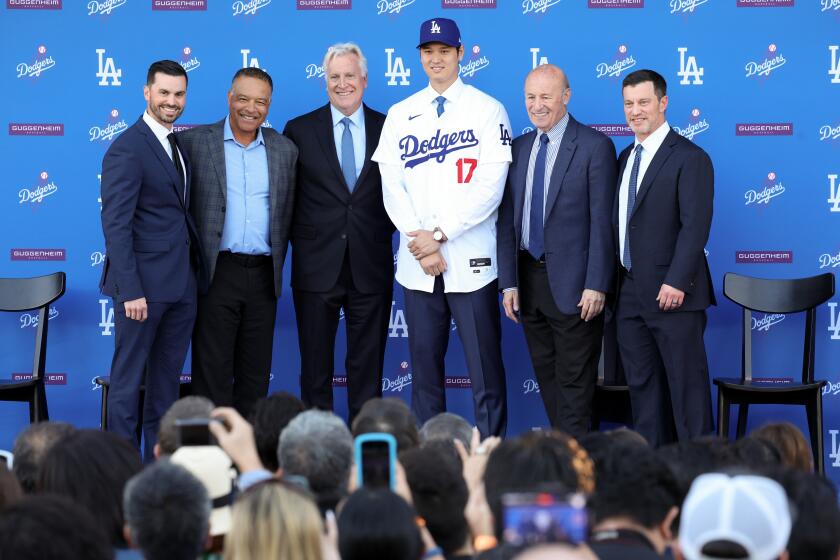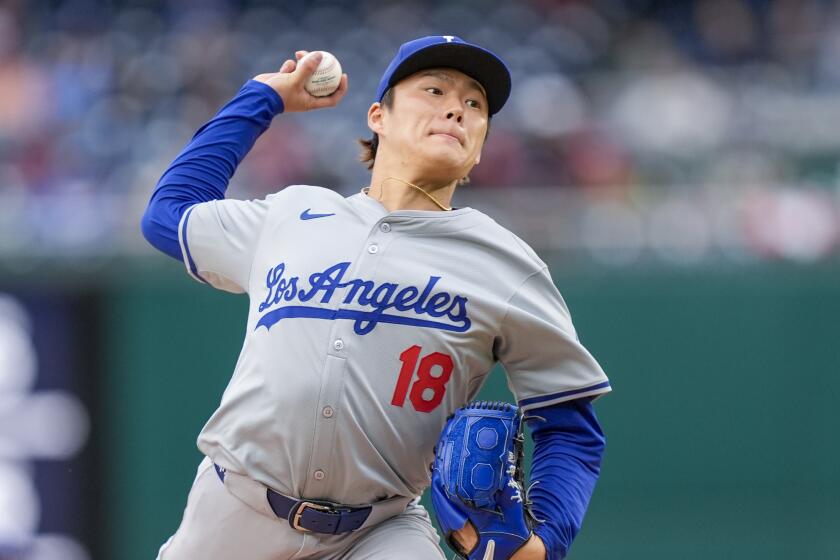Dodgers Dugout: Was the A.J. Ellis trade a good deal?

Hi, and welcome to another edition of Dodgers Dugout. My name is Houston Mitchell, and I wish A.J. Ellis a fond farewell.
Looking at Game 3 of the Giants series
--The Dodgers lost after nearly being no-hit by Matt Moore. They still have a two-game division lead with the Chicago Cubs coming into town. Now, let’s get on to the more important news from Thursday.
Goodbye, A.J.
The Dodgers traded catcher A.J. Ellis to the Philadelphia Phillies on Thursday for catcher Carlos Ruiz. It’s a move that surprised many because Ellis is well-liked by his teammates and Clayton Kershaw loved pitching to him. So why did the Dodgers do it? They wanted someone who hit left-handers better than Ellis.
Ruiz has an .830 OPS against left-handers this season, versus Ellis’ .616.
Lifetime, Ellis is hitting .235 with a .740 OPS against lefties, while Ruiz is hitting .275 with an .814 OPS.
So is this a good trade? Before I answer, let’s take a look at another number: What did Kershaw do with each man behind the plate?
In his career, Kershaw has a 1.97 ERA when pitching to Ellis. That’s impressive. What about Yasmani Grandal? When pitching to him, Kershaw had a 1.98 ERA. Sure, he has pitched far more to Ellis than Grandal, but there has been no discernible difference when pitching to either.
Ellis was going to be a free agent after the season and probably would not have been re-signed. Ruiz has a $4.5-million team option for next season, or a $500,000 buyout.
So, looking at the numbers, the trade seems good. Ruiz is a much better player than Ellis.

The team traded backup catcher A.J. Ellis to the Philadelphia Phillies in a trade that shocked its clubhouse.
However, if you are a believer in team chemistry, the timing of the deal is horrible. Ellis is loved by his teammates. The Dodgers are playing their best ball of the season the last six weeks (during which, it should be noted, Ellis has not played much). Kershaw loves the guy. Why trade him the day of a key game against the Giants and before a big weekend series with the Cubs?
I’m not a big believer in team chemistry. Lots of teams hated each other and won titles. Lots of teams loved each other and finished last. The Dodgers have put 27 players on the DL, so the clubhouse is basically a revolving door of new players. Trading a seldom-used backup catcher shouldn’t break a team, and if it does, then that team probably wasn’t going to win a World Series anyway.
However, when you have a team that is on a roll, why trade a guy to whom your best player, Kershaw, loves pitching? With Kershaw returning from the disabled list soon (hopefully), why make his recovery a little tougher by trading away his friend, the guy who is on his same wavelength?
Why trade a guy his teammates love, just for Ruiz, who might give them a couple of extra hits down the stretch? Was it worth making players in the clubhouse unhappy or causing them to lose focus as the shock of the trade hit them? Every Dodgers fan could detect a noticeable change in team morale and energy this season. Why take a chance on disrupting that by trading one of the best clubhouse guys?
Grandal is going to get the bulk of playing time down the stretch, so I don’t see how Ruiz’s bat is going to make a huge difference. So, in looking at it from that perspective, this trade is puzzling.
But looking at it from just a stats perspective, it makes sense. And that’s how Andrew Freidman views baseball: totally from a stats perspective. It’s like he’s running the world’s most expensive Fantasy Baseball team, where you don’t need to worry about what the players think because they are just interchangeable numbers with no personality or emotion. I don’t know if that is good or bad, it’s just the way it is.
So, from a pure stats perspective: great trade. From a clubhouse perspective: Too soon to tell. But again, if the team can’t handle the trading of a backup catcher, then it’s not much of a team.
But one thing I do know: The first time Ellis plays against the Dodgers at Dodger Stadium, he deserves a huge standing ovation. As a fan, I will miss him. But I’ll miss him a lot less if Ruiz hits well down the stretch.
The rest of the schedule
HOME (16 games): Aug. 26-28 vs. Chicago Cubs, Sept. 2-4 vs. San Diego, Sept. 5-7 vs. Arizona, Sept. 19-21 vs. San Francisco, Sept. 22-25 vs. Colorado
ROAD (19 games): Aug. 29-31 at Colorado, Sept. 9-11 at Miami, Sept. 12-14 at New York Yankees, Sept. 15-18 at Arizona, Sept. 27-29 at San Diego, Sept 30-Oct. 2 at San Francisco.
Trade update
How the players acquired at the trade deadline are doing:
Josh Reddick: .143 (10 for 70)
Rich Hill: 1-0, 0.00 ERA
Jesse Chavez: 1-0, 4.20 ERA in 11 games
Josh Fields: 1-0, 4.66 ERA in 11 games, currently in the minors
Ask Ross Porter
Former Dodgers announcer Ross Porter will be answering select reader questions for the rest of the season. Email me a question for Ross, and I will pass it on. His latest response:
Dave Pratt asks: Ross, how has the method and criteria for counting home-game attendance for the Dodgers changed over the years?
Ross: Tomorrow afternoon, when they host the Cubs, the Dodgers will surpass the 3-million mark in home attendance for arecord 28th time, including 15 of the past 16 seasons. The Dodgers once more are leading baseball with an averagehome crowd of just over 45,000 this year. Last season, they were No. 1, averaging 46,479, and were the only team to perform before turnouts over 50,000 — reaching that figure on 12 home dates. The smallest Chavez Ravine audience in 2015 was a shade under 38,000.
The franchise reached a high of 3.86 million fans in 2007 and never has drawn below 1.58 million at Dodger Stadium.Dave, National League clubs announced an actual turnstile count through 1992, but now, both leagues define attendance as tickets SOLD, not tickets USED. That is because of revenue sharing. Teams contribute 31% of the revenue they generate into a pool to be redistributed among those franchises that produce the fewest dollars in a season.
In baseball, the average no-show rate is 18% to 20%. The greater the number of season tickets sold, the greater the number of no-shows. Much of this is done for accounting purposes. Sellouts drive sponsorships. Announced sellouts are usually below seating capacity. Some fans get tickets without paying full price, maybe obtaining season tickets deeply discounted. Employees receive complimentary ducats, as do sponsors, visiting teams and umpires.The Dodgers have a permit with the city of Los Angeles that limits capacity at the stadium to 56,000, still the largest in baseball. Denver is next at just over 50,000.
Major league baseball drew nearly 74 million fans last year. No other sports league in the world reached 23 million. The average number of tickets sold per date in baseball’s major leagues was 30,517. Remember, all these attendance numbers are based on tickets sold, not tickets actually used.
What Vin Scully means to me
I asked you to tell me your best Vin Scully memory, and I got a lot of responses. I will publish selected ones in each newsletter. And keep emailing them to me.
Bob Pinzler: My experience with him goes back to Brooklyn, where I was born in 1949. I was raised in a Dodger household and went to Ebbets Field numerous times. Vin has been part of my life from the womb.
When they left Brooklyn, I used to follow the Dodger broadcasts from my parents’ summer house in the Catskill Mountains due to the miracle of the AM radio “skip,” where those signals bounce off the ionosphere, to be picked up by radios far away. The Dodger games at that time were on a Denver radio station, and I used to keep score and then “recreate” the game for the other kids in our neighborhood. (The New York newspapers we received there did not have the “late games” included, so I was the local sports source.)
Fast forward to 1976, when I got a job in L.A. and picked up my rental car at the airport. I turned on the radio and, by chance or design, it was tuned to the Dodger station. The first voice I heard having arrived here was Vin Scully.
I knew I was home.
The TV situation
If you would like to complain about the Dodgers’ TV situation, you have three options: The Dodgers, Time Warner Cable and whatever local cable or satellite provider you have that doesn’t carry the Dodgers. Here’s who to contact:
For the Dodgers, click here or call (866) DODGERS, or (866) 363-4377. (I hope you like form letters).
For Time Warner, click here.
For DirecTV, call (800) 531-5000 or click here.
For your local cable or satellite provider, consult your bill for the customer service number and for the website.
And finally…
Vin Scully talks about the history of Friday the 13th. Watch and listen here.
Have a comment or something you’d like to see in a future Dodgers newsletter? Email me and follow me on Twitter: @latimeshouston
More to Read
Are you a true-blue fan?
Get our Dodgers Dugout newsletter for insights, news and much more.
You may occasionally receive promotional content from the Los Angeles Times.







